DIY Lavender Bath Salts (4 Ways)
This post contains affiliate links. If you click and make a purchase, I may receive a commission. Thanks.
Looking for a DIY lavender bath salts recipe?
You came to the right place. I have not one, but 4 awesome recipes for you!
In this post, I will show you 4 different ways to make homemade lavender bath salts. Whether you like your bath salts simple, moisturizing or fun and fizzy, you will find a recipe that fits your needs.
My goal is to show you how to make bath salts yourself and show you the possibilities. Once you learn the recipes, it is so easy to modify them. Simply switch up the color and essential oils and you will have totally different bath salts.
In this post you will learn:
– The benefits of using lavender bath salts;
– How to safely add essential oils to your homemade bath salts
– Basic lavender bath salts recipe – simple and effective
– Rose lavender bath salts recipe (a.k.a queens need to relax too)
– Moisturizing DIY lavender bath salts for beautiful skin
– Fizzy bath salts recipe – for color and fun
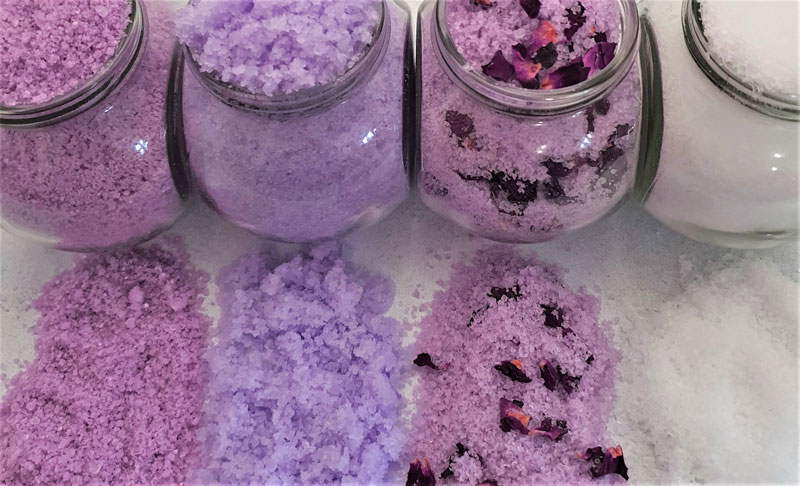
Lavender bath salts benefits
Both bath salts and lavender essential oil have therapeutic effects that help to relax body and mind. The two compliment each other perfectly, so if you are after a relaxing bath experience, this combo is hard to beat.
Benefits of Epsom bath salts
All the benefits of Epsom salts come from its high content of magnesium. Magnesium can be absorbed into the bloodstream through skin, which is why soaking in Epsom salt is so effective.
Reduced stress & better sleep. People feeling stressed or anxious often benefit from taking an Epsom salt bath. This is because the magnesium that we get from soaking in Epsom salts boosts brain neurotransmitters that are responsible for inducing sleep and reducing stress. It also helps promote melatonin release, a sleep-inducing hormone.
Reduced muscle soreness. Soaking in a magnesium rich Epsom salt bath, helps reduce muscle soreness, inflammation, and swelling.
Benefits of Lavender essential oil
Lavender essential oil is one of the most popular, and versatile essential oils used in aromatherapy.
You know why?
BECAUSE IT WORKS.
Lavender essential oil promotes relaxation and healthy sleep. It can also help reduce anxiety and depression.
The internet is full of people raving about these amazing lavender essential oil benefits. Here are also some studies that confirm the claims:
One study of elderly people with sleeping troubles concluded that inhaling lavender oil can have a positive effect on improving sleep quality and other aspects related to sleep. In fact, the study showed that lavender oil was as effective as some commonly prescribed sleep medications.
Here’s another study that concluded that lavender essential oil was effective at helping with sleep issues in college students.
Benefits of baking soda in a bath
This post will teach you how to make 4 different DIY lavender bath salts. 2 of these recipes include baking soda. Baking soda is an optional ingredient (except for the bubbling recipe where it is mandatory), so you can choose to add it or omit it.
What does baking soda do for bath salts?
Baking soda is added to bath salts for its soothing properties. Baking soda bath can help with skin irritation, scaly skin and itching. It can be a big relief for those with eczema and psoriasis.
The reason baking soda works is that it is alkaline and so it makes your bath water slightly more alkaline too. It also changes how the bath water feels, making it noticeably silkier.
When deciding about adding baking soda to bath salts, consider not only the benefits but also the final look of your bath salts. If you want a clean, crystal-like looking bath salts – skip the baking soda. If you add baking soda, your bath salts mix will look more like a bath soak.
How to use essential oils in bath salts
There is one VERY IMPORATNT RULE when it comes to safely adding essential oils to your bath salts.
Essential oils must be diluted.
Undiluted essential oil can irritate and even burn your skin. This is because oils don’t disperse in bath water and float on top of it.
There are a few ways to dilute essential oils before adding to bath salts. I will talk more about the options in my next post (coming soon).
The easiest and most popular option is to dilute essential oils in a carrier oil, such as sweet almond oil or fractionated coconut oil. You simply need to dilute every 5-20 drops of essential oil in a tablespoon of a carrier oil before adding it to the bath salts. This is an option I am using for all 4 lavender bath salts recipes.
You can use any oil for your homemade bath salts, but have in mind that dark oils will alter the color of your salts. I recommend using fractionated coconut oil because it has no color, no scent and has a light, silky feel.
Dispersing oils
Something to keep in mind when adding vegetable oils to your bath salts is that just like essential oils, they do not disperse in water. This means that you may see droplets of oil floating on top of your bath water. The difference is that these oil droplets contain diluted essential oils and are totally safe. You can even rub it on your skin.
If you want your essential oils to emulsify with water fully, consider using a solubiliser. I use Polysorbate 80 in my recipes, as it is very versatile and easy to find.
(If for any reason you don’t want to use a solubiliser, I suggest experimenting with Fractionated Coconut oil. In my experience, it gives the best results without using a solubiliser)
Another thing I wanted to mention is that you don’t necessarily need to use Lavender essential oil alone to get the relaxing benefits. There are really nice calming and relaxing essential oil blends with lavender that you can try. I really like a lavender and cedarwood blend before bedtime. You can find a couple more relaxing blends in the picture below.
Save for later:
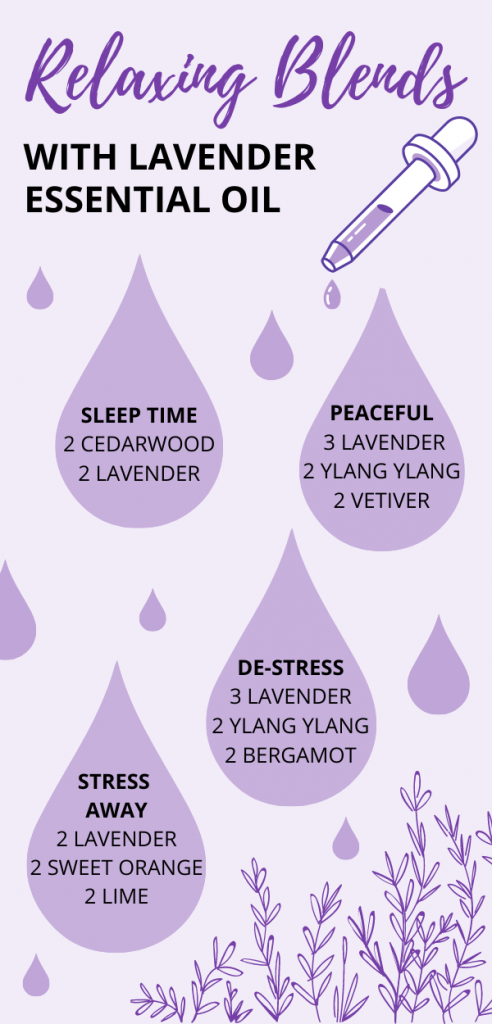
Now that you understand the ingredients, let’s get into the recipes!
DIY Lavender Bath Salts Recipes
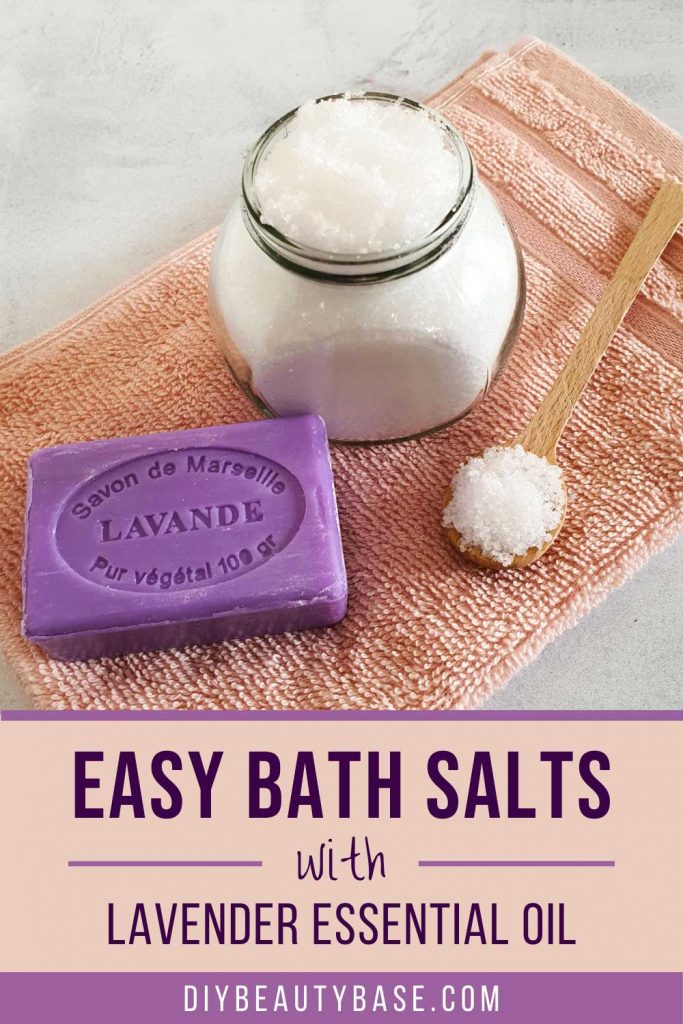
(Easy) Basic Lavender Bath Salts Recipe
This is a very simple bath salts recipe. Perfect if you just want the benefits of the salts and lavender but don’t need the color or the fun factor.
1 cup of Epsom Salts (Epsom Salts in bulk)
1 tablespoon of Fractionated coconut oil
12 drops of Lavender essential oil
Instructions:
1. Start by mixing fractionated carrier oil and lavender essential oil in a small container.
2. Then add it to your Epsom Bath salts and mix well.
3. Store it in an airtight container in a cool dry place.
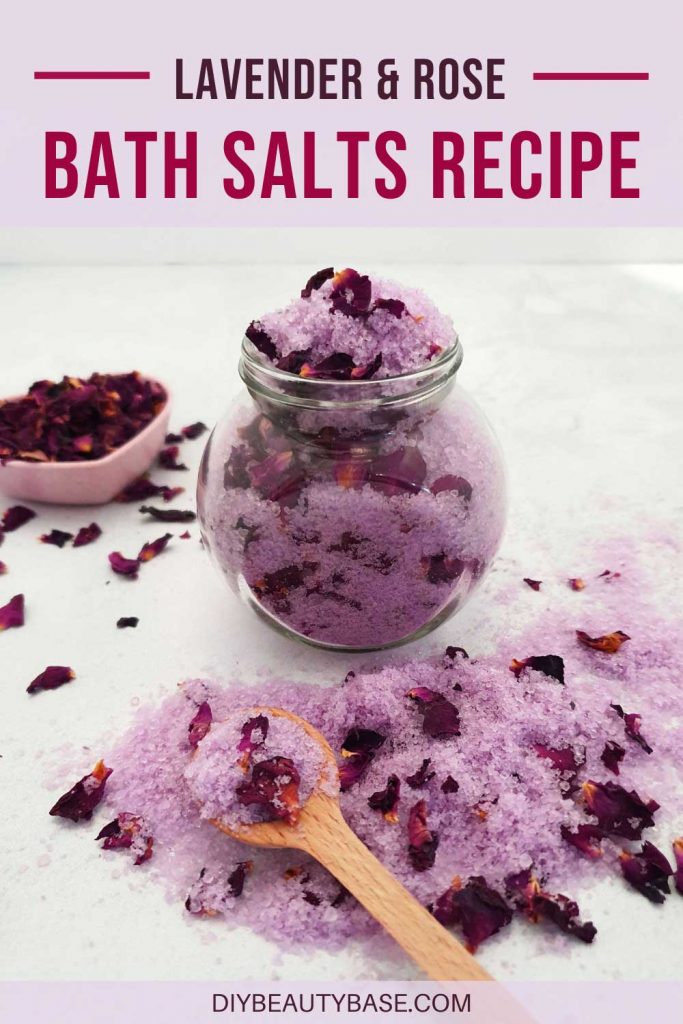
Rose Lavender Bath Salts Recipe (a.k.a Queens Need To Relax Too)
For this recipe, we will add some color and beautiful rose petals. I personally enjoy my bath soaks more when the bath water looks pretty.
You may wonder why I choose to use rose petals instead of lavender buds for a lavender bath salts recipe… And let me tell you, lavender buds in a bath look like tiny bugs floating on water. Trust me, you don’t want that. Choose rose petals or colorful flowers instead.
However, there is more to the rose-lavender blend than just the looks. The blend is calming and feminine. The simplicity of lavender pairs very well with the complex, sensual notes of rose essential oil. Think “calm and grace”.
Recipe
1 cup of Epsom Salts (Epsom Salts in bulk)
1 tablespoon of Fractionated coconut oil
10 drops of Lavender essential oil
4 drops of Rose essential oil
1/2 tbsp of Polysorbate 80 (optional)
Instructions
1. Start by mixing fractionated carrier oil, essential oils and Polysorbate 80 (optional) in a small container.
2. Then add it to your Epsom Bath salts and mix well.
3. Add couple drops of purple dye and mix. Mixing with hands works best for me (use gloves!).
* You may feel tempted to first add the color and only then your oils. But I find that having the oil in the bath salts makes color mixing easier.
4. Add rose petals and mix.
3. Store it in an airtight container in a cool dry place.

Moisturizing DIY Lavender Bath Salts
This is a great recipe if you want to relax and nourish your skin at the same time. The recipe includes baking soda to calm down the skin and a higher amount of moisturizing oils. I mixed up sweet almond oil and fractionated oil, since FCO oil will not be moisturizing enough on its own. This recipe should be made with a solubiliser.
Recipe
1 cup of Epsom Salts (Epsom Salts in bulk)
1/4 cup of Baking soda
5 tbsp of Sweet Almond Oil
2 tbsp of Fractionated coconut oil
6 drops of Lavender essential oil
4 drops of Ylang Ylang essential oil
4 drops of Bergamot essential oil
1.5 tbsp of Polysorbate 80
* You can use liquid dye instead. I used mica powder to show you the variety of options 🙂
Instructions
1. In a large bowl, mix Epsom salts and baking soda.
2. In a separate small bowl, mix your carrier oils, essential oils and Polysorbate 80.
3. Then add it to your Epsom Bath salts and mix well.
4. Add a little bit of purple mica powder and mix. Mixing with hands works best for me (use gloves!). Keep adding more mica until you are happy with the color.
5. Store it in an airtight container in a cool dry place.
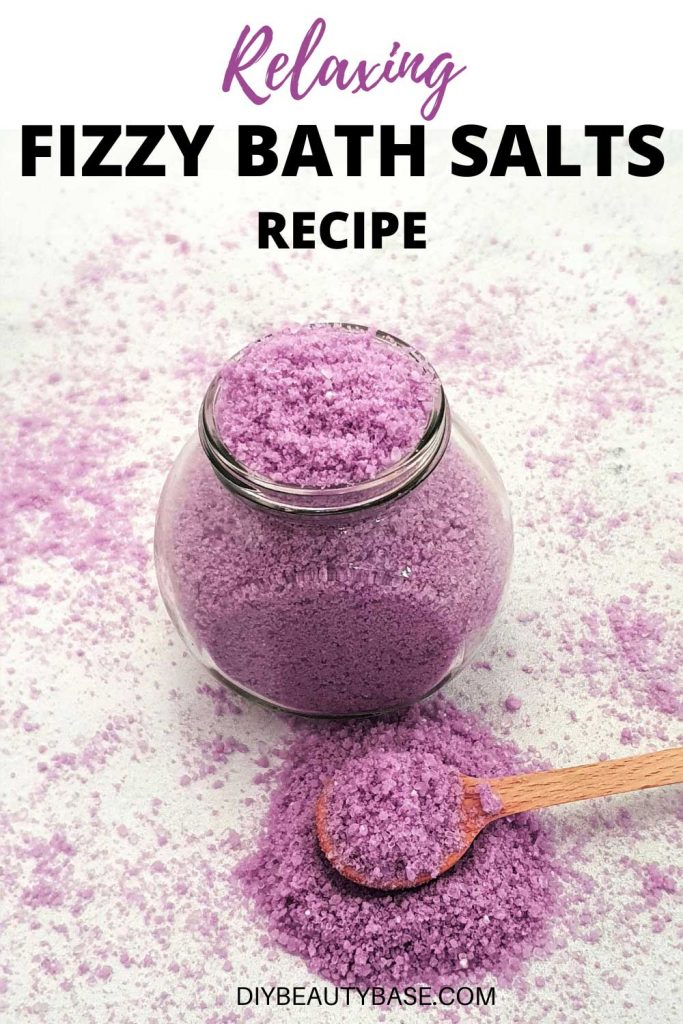
Relaxing Fizzy Bath Salts Recipe
This is the best bath salts recipe for those who love bath bombs. Also, for kids because of all the fun fizzing and color.
Recipe
1 cup of Epsom Salts (Epsom Salts in bulk)
1/2 cup of Baking soda
1/4 cup of Citric acid
1 tablespoons of Fractionated coconut oil
6 drops of Lavender essential oil
6 drops of Sweet orange essential oil
6 drops of Lime essential oil
1/2 tbsp of Polysorbate 80
Instructions
1. In a large bowl, mix Epsom salts and baking soda.
2. In a separate small bowl, mix your carrier oils, essential oils and Polysorbate 80.
3. Add couple drops of purple dye and mix. Mixing with hands works best for me (use gloves!).
* You may feel tempted to first add the color and only then your oils. But I find that having the oil in the bath salts makes color mixing easier.
4. Add citric acid and mix.
5. Store it in an airtight container in a cool dry place.
What can I use in place of Epsom salts?
You can use Sea salt or Himalayan salt. To learn more about what different salts do and how to make perfect bath salts read this post (coming soon).
Shelf life
The shelf life of these homemade lavender bath salts is about 2 years. Salt is extremely shelf-stable and doesn’t expire. Essential oils have a long shelf life of about 4-5 years. Most carrier oils, however, will last only for 1 to 2 years.
How to use these bath salts
Add 1 cup of homemade bath salts to a warm bath and soak for at least 20 mins to get the full benefit of the Epsom salts and the Lavender essential oil .
I hope you enjoyed these lavender bath salts recipes. Let me know in the comments below which recipe you liked the most! 🙂
